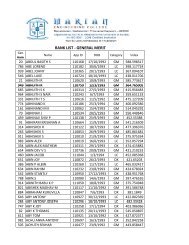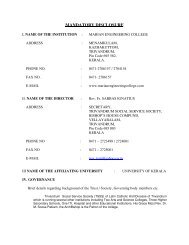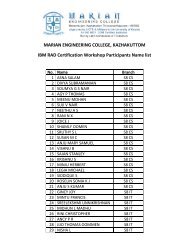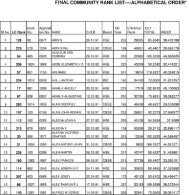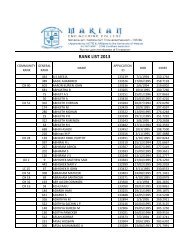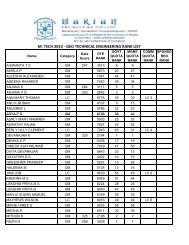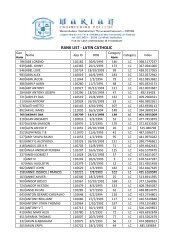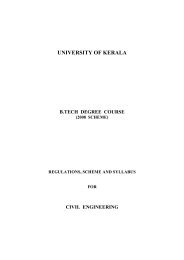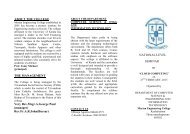UNIVERSITY OF KERALA - Marian Engineering College
UNIVERSITY OF KERALA - Marian Engineering College
UNIVERSITY OF KERALA - Marian Engineering College
You also want an ePaper? Increase the reach of your titles
YUMPU automatically turns print PDFs into web optimized ePapers that Google loves.
B.Tech Comp. Sc. & Engg., University of Kerala 55<br />
08.605 HIGH PERFORMANCE MICROPROCESSORS 3 – 1 – 0<br />
Module I (18 hours)<br />
Intel 80286,80386 and 80486 microprocessors- System architecture, Modes- Real mode- Protected mode -<br />
Virtual 8086 mode, Segmentation and Paging, Protection schemes, Management of task, Enhanced<br />
instructions, Intel Pentium processor –System architecture-Branch prediction-Pentium memory management,<br />
Pentium Pro –Architecture and Special features, Pentium 4- Architecture-memory system-Hyper Threading<br />
Technology.<br />
Module II (16 hours)<br />
Reduced Instruction Set Computers (RISC)- Instruction execution characteristics, The use of a large register<br />
file, Compiler based Register optimization, Reduced Instruction Set Architecture, RISC Pipelining, MIPS<br />
R4000, SPARC, The ARM processors- ARM registers- ARM instructions- Memory access instructions and<br />
addressing modes, register move instructions, arithmetic and logic instructions and branch instructions<br />
(Programming not required) , CISC vs RISC.<br />
Module III (18 hours)<br />
8051 Micro controller hardware- I/O pins, ports and circuits- External memory- Counters and Timers- Serial<br />
Data I/O- Interrupts. 8051 instruction set- Addressing modes- Assembly language programming- I/O port<br />
programming- Timer and counter programming- Serial communication- Interrupt programming- 8051<br />
interfacing to LCD, Sensors and Keyboard.<br />
Text Books:<br />
1. Advanced Microprocessors and Peripherals, 2 nd Edn – A.K. Ray, K.M. Bhurchandi, Tat McGraw Hill<br />
(Module I & III)<br />
2. Computer Organization and Architecture designing for performance, 7 th Ed – William Stalling,<br />
Pearson Education ( Module II)<br />
3. Computer Organization, 5 th Edn – C.Hamacher, Z. Vranesic, S. Zaky, Mc Graw Hill (Module II- ARM Processors)<br />
4. The 8051 Microcontroller Archetecture Programming and Application, 2 nd Edn – Kennath J Ayala,<br />
Penram International Publishers (India) (Module III)<br />
5. The 8051 Microcontroller and Embedded Systems – Mohammed Ali Mazidi and Jancie Gillispie Mazidi,<br />
Pearson Education Asia (Module III)<br />
Reference Books:<br />
1. Microprocessors and Interfacing – Douglas V Hal, McGraw Hill.<br />
2. The Intel Microprocessors 8086/88, 80286,80386,80486,Pentium ,Pentium Pro, PentiumII, PentiumIII, Pentium 4<br />
Archetecture,Programming and interfacing – Barry.B.Brey, PHI.<br />
3. Microprocessors and Microcontrollers : Architecture, Programming and System Design 8085, 8086, 8051, 8096<br />
– K. Kant, PHI.<br />
4. Microprocessor, Microcomputer and Applications, 3 rd Edn – A. K. Mukopadhyaya, Narosa.<br />
Internal Continuous Assessment (Maximum Marks-50)<br />
25 Marks - Tests (minimum 2)<br />
15 Marks - Assignments (minimum 3) such as home work, problem solving, literature survey, seminar,<br />
term-project, software exercises, etc.<br />
10 Marks - Regularity in the class<br />
University Examination Pattern<br />
PART A: Short answer questions 10 x 4 marks=40 marks<br />
All questions are compulsory. There should be at least three questions<br />
from each module and not more than four questions from any module.<br />
PART B: Descriptive/Analytical/Problem solving questions 3 x 20 marks=60 marks<br />
Candidates have to answer one question out of two or two questions<br />
out of four from each module<br />
Maximum Total Marks: 100



